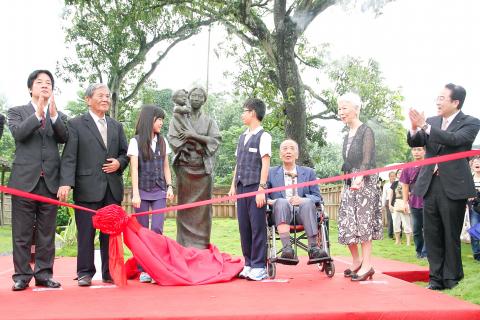More than 300 dignitaries and guests gathered in Greater Tainan on Sunday to commemorate Japanese civil engineer Yoichi Hatta and his wife, Toyoki Yonemura, for their dedication and contribution to Taiwan’s economy and agricultural development.
The event was held at the Yoichi Hatta Memorial Park(八田與一紀念園區) at the Wushanto Reservoir (烏山頭水庫), one of the projects designed and built by Hatta during his 32 years of service in Taiwan from 1910 to 1942. A large Japanese delegation also attended the event, including Hatta’s daughter-in-law, Ayako, and other family members.
Greater Tainan Mayor William Lai (賴清德) unveiled a bronze statue of Yonemura, a commissioned artwork by Yoshiki Murai.

Photo: CNA
Organizers said the statue gives a full rendering of the couple’s moving life story, with Yonemura as a virtuous woman and a loving wife, providing a resolute supporting force to her husband.
“Hatta made great contributions to Taiwan with his construction of irrigation networks and water reservoirs. Farmers’ lives and agricultural development benefited enormously from his engineering projects... He turned barren lands into productive granaries,” Lai said.
“He is also the link to the sister-city friendship between Greater Tainan and Kanazawa City, Hatta’s hometown,” the mayor said.
Hatta, also known among Taiwanese as the “Father of the Chianan Irrigation System (嘉南大圳),” was a civil engineering graduate from the then-Tokyo Imperial University (now the University of Tokyo) in 1910, and came to Taiwan that year.
Working for the Japanese colonial government at the time, Hatta was the chief engineer who designed and built a vast network of irrigation channels, measuring more than 16,000km in length, to cover more than 100,000 hectares of farmland around Chiayi and Tainan.
The project took 10 years and was completed in 1930. It raised the productivity of the southern plains, with annual harvests of 83,000 tonnes of rice, sugarcane and other crops, directly benefiting 600,000 farmers.
Hatta was killed in 1942, onboard a Japanese ship that was sunk in a submarine attack during World War II. He was on his way to Manila, where the Japanese government had sent him to develop agriculture in the Philippines.
His body was found, and after cremation, a portion of his ashes was taken to Taiwan for burial in a gravesite at the reservoir.
Local residents had built a statue for the Japanese engineer in 1931 to pay tribute to his contributions. However, they hid the statue for 40 years from 1941, fearing the Japanese government and later the Chinese Nationalist Party (KMT) government would want to melt down the statue for war materials and for political reasons.
Only when the political climate began to change in 1981 did local residents uncover the statue for reinstallation at the Wushanto Reservoir park.
Despite her sadness at her husband’s death in 1942, Yonemura remained in Taiwan with her children until the end of World War II.
Hatta and Yonemura raised two boys and six girls in their 32 years in Taiwan. When Japan surrendered in 1945, all Japanese citizens were ordered to return home, including all the Hatta children.
Yonemura committed suicide on Sept. 1, 1945, by jumping into the reservoir her husband had built. Before her death, Yonemura had told one of the family members that her life was devoted to her husband and she wanted to remain by her husband’s side, so both of them could remain in the area in spirit to protect the reservoir and the irrigation networks.

An essay competition jointly organized by a local writing society and a publisher affiliated with the Chinese Communist Party (CCP) might have contravened the Act Governing Relations Between the People of the Taiwan Area and the Mainland Area (臺灣地區與大陸地區人民關係條例), the Mainland Affairs Council (MAC) said on Thursday. “In this case, the partner organization is clearly an agency under the CCP’s Fujian Provincial Committee,” MAC Deputy Minister and spokesperson Liang Wen-chieh (梁文傑) said at a news briefing in Taipei. “It also involves bringing Taiwanese students to China with all-expenses-paid arrangements to attend award ceremonies and camps,” Liang said. Those two “characteristics” are typically sufficient

A magnitude 5.9 earthquake that struck about 33km off the coast of Hualien City was the "main shock" in a series of quakes in the area, with aftershocks expected over the next three days, the Central Weather Administration (CWA) said yesterday. Prior to the magnitude 5.9 quake shaking most of Taiwan at 6:53pm yesterday, six other earthquakes stronger than a magnitude of 4, starting with a magnitude 5.5 quake at 6:09pm, occurred in the area. CWA Seismological Center Director Wu Chien-fu (吳健富) confirmed that the quakes were all part of the same series and that the magnitude 5.5 temblor was

The brilliant blue waters, thick foliage and bucolic atmosphere on this seemingly idyllic archipelago deep in the Pacific Ocean belie the key role it now plays in a titanic geopolitical struggle. Palau is again on the front line as China, and the US and its allies prepare their forces in an intensifying contest for control over the Asia-Pacific region. The democratic nation of just 17,000 people hosts US-controlled airstrips and soon-to-be-completed radar installations that the US military describes as “critical” to monitoring vast swathes of water and airspace. It is also a key piece of the second island chain, a string of

The Central Weather Administration has issued a heat alert for southeastern Taiwan, warning of temperatures as high as 36°C today, while alerting some coastal areas of strong winds later in the day. Kaohsiung’s Neimen District (內門) and Pingtung County’s Neipu Township (內埔) are under an orange heat alert, which warns of temperatures as high as 36°C for three consecutive days, the CWA said, citing southwest winds. The heat would also extend to Tainan’s Nansi (楠西) and Yujing (玉井) districts, as well as Pingtung’s Gaoshu (高樹), Yanpu (鹽埔) and Majia (瑪家) townships, it said, forecasting highs of up to 36°C in those areas